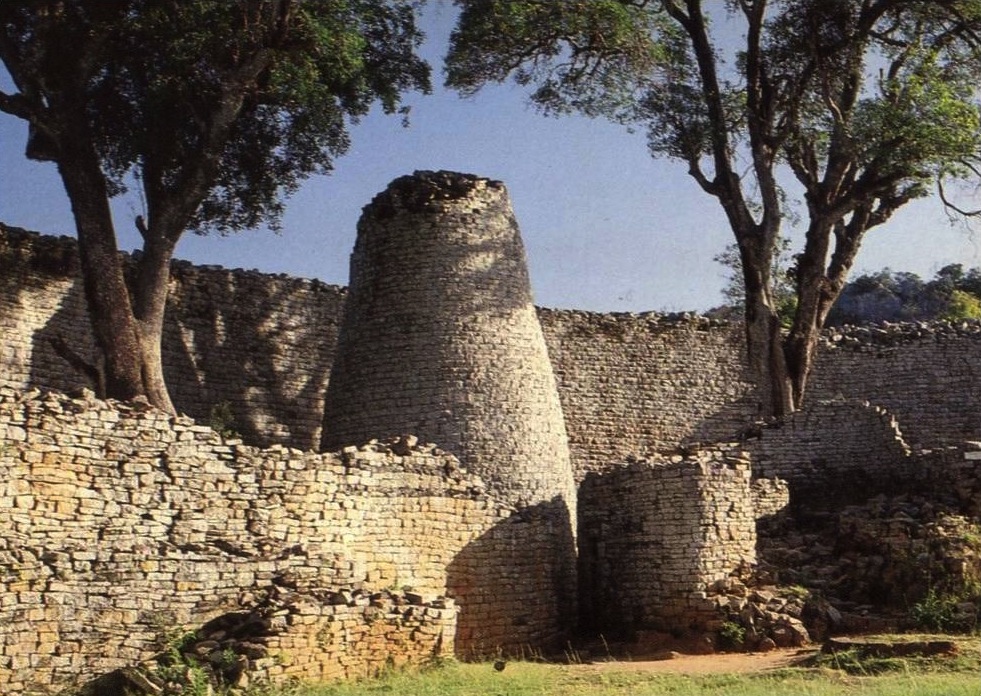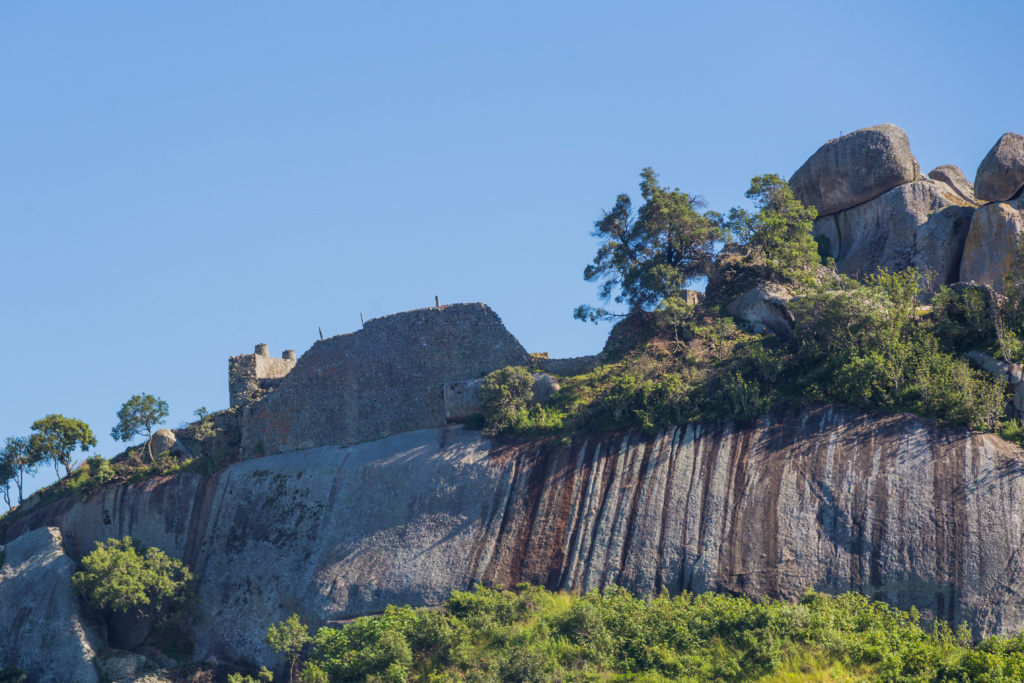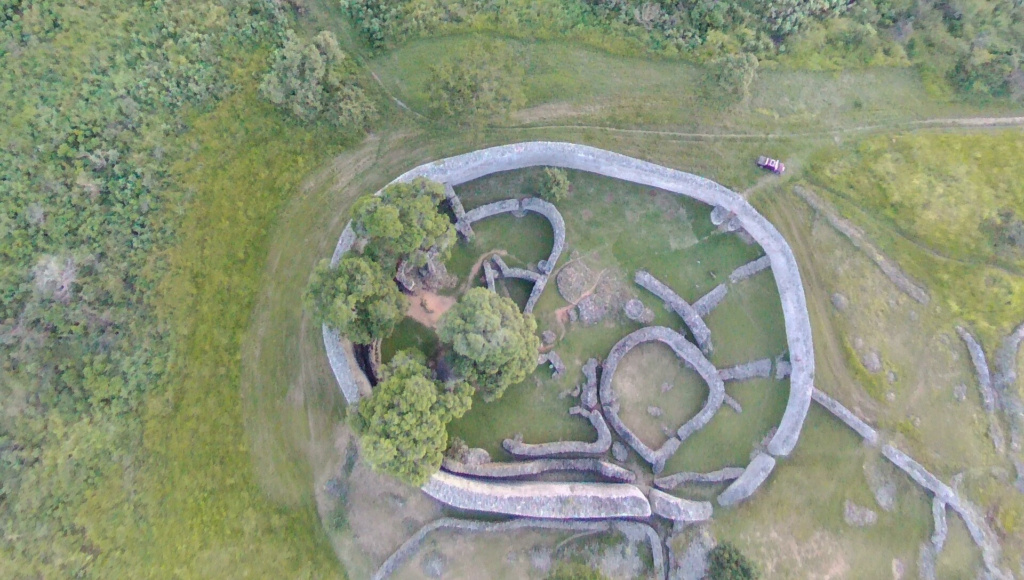Great Zimbabwe is found in the south-central zimbabwe and 27km south-east of Masvingo town. It was declared a World Heritage Site in 1986. Great Zimbabwe is Southern Africa’s largest pre-colonial settlement. The name Zimbabwe refers to a big house of stone. The once thriving city is an iron age or later farming community settlement which flourished between 1290 and 1450AD. The site sits on 720 ha of land and is the largest of more than 300 zimbabwe-type sites scattered across Southern Africa. In Zimbabwe some of such sites are Khami, Dhlodhlo, Naletale, Zinjanja and Chibvumani just to mention but a few. Outside Zimbabwe there is Manekeni in Mozambique and Domboshaba in Botswana. However there are some which are yet to be discovered and explored.

The most eye catching remains at Great Zimbabwe are massive dry stone walls spread across the landscape. These walls built without any binding material make enclosures of different sizes. Piles of granite stones are a testimony of places where other walls once stood. Within and outside these stone enclosures are dhaka houses, which are evidenced by floors and walls. These served as houses and granaries.
Great Zimbabwe is divided into four components, which are, The Hill Complex, Great Enclosure, Valley Ruins and Periphery Settlements. The Hill Complex is on one of the highest hills in a low undulating surrounding. The steep sided hill towers 80m above the general landscape. The Hill can sharply be spotted at about 10km before one gets to the site. Stone walls which incorporate natural boulders form the four main enclosures, which are, the Western, Recess, Southern, Eastern and Cleft Rock Enclosures.
The other component of Great Zimbabwe is the Great Enclosure which is located on the low planes of the estate. This structure presents the most spectacular and outstanding feature of the site. The enclosure marks the epitome of dry stone wall masonry. The Great Enclosure is an oval space surrounded by a 250m girdle wall, whose thickest point is 6m and highest point is 10m. This makes Great Enclosure the biggest stone structure in Southern Africa. The parameter wall encloses the famous conical tower which is approximately 10m high and its diameter at the base is 5m.
The Valley and peripheral sides have small walls which show the evolution of dry stone wall architecture. They form small enclosure which housed several Dhaka structures.
The different components of the site have yielded invaluable artefacts for archaeologists to reconstruct the social, political and economic life at Great Zimbabwe. These are both exotic and indigenous artefacts such as pottery, beads, ornaments of different metals and faunal remains were excavated. Among these artefacts are the famous eight zimbabwe birds which are carved on soapstone. Of the eight, six were found in the Eastern Enclosure of the Hill Complex, one on a balcony facing the Western Enclosure and the most aesthetically appealing was found in the Valley enclosures.


Archaeology and Monuments Department
 |
| An aerial view of the great enclosure |
Great Zimbabwe is a research institution, which focuses on acquiring information from within or outside Masvingo. This is done following its research and conservation policy. There are various research methods, which include excavations, surveys, and interviews on which results are used by internal and external researchers is coordinated by the Archaeology and Monuments Department. The department also does the accessioning and documentations of acquired collections, as well as the management of Provincial Heroes Acres in the region.
Surveying Department
The Surveying Department coordinates the conservation of dry stonewalls and Dhaka structures at Great Zimbabwe and through out the country. Furthermore it has become a centre for sharing information on the conservation of dry stone walls in sub Saharan Africa. There is evidence that conservation of Great Zimbabwe started by the original builders especially in the Hill Complex where a supportive wall was constructed to cover up the numerous bulges of the main western wall. Systematic measures to protect and preserve the site can be traced back to 1986. A measure to protect and return the cultural significance of the site was put in place since it was observed that the stonewalls are continuously collapsing.
The department undertakes the following activities:
Intervention and Restoration projects
 |
| Workers restoring a wall |
Restorations are usually done on areas that are found to be continuously deteriorating structurally, on walls that suddenly collapse or on walls that collapsed long ago if it is necessary. Great Zimbabwe has an ongoing process of activities, which include Glass Control, Firebreaks, Road maintenance, and control of Exotic Trees.
Monitoring of dry stone walls
General monitoring is a means of identifying and quantifying areas within the dry stonewalls threatened with collapse. Monitoring formed an integral part of an overall inspection to assess the condition of the site. The objective of monitoring and inspections conducted on structures is to:
- Quantify the movement and structural instability.
- Identify causes of deterioration.
- Identify areas where significant progressive movement of blocks, portions or the whole wall are occurring.
- Provide information as a basis of management and control off structural stability.
- Yields data to assist in the formulation of maintenance and interventive strategies.
- Produce useful data upon which an assessment can be made of whether an intervention is necessary or not.
Education Department
While Great Zimbabwe is ideal for reciting details of the Iron Age period settlement patterns in general, it also provides an insight into life at this archaeological Site, in particular the organization of society, economy, politics and religion-cultural life at Great Zimbabwe. Aspects like shelter, economy, social interaction, religion is relevant to the Primary school syllabus. On the other hand economic, political and source based history is relevant to secondary school curricula. Prehistory, Archaeology, Tourism, Architecture attracts the interest of University students and scholars visiting the site.
Therefore the Heritage Education Department coordinates the following activities:
- Educational Visits.
- Outreach programmes.
- Adopt – the- Site programmes.
- Heritage Education Quiz Competitions.
- Promote Tourism related activities.
- Guided tours.
Southern Region Focus On Exhibitions
The Great Zimbabwe Museum
The Great Zimbabwe Museum exhibits some of the fine original archaeological artefacts recovered from the site including the famous Zimbabwean birds. The birds are a unique archaeological collection and were all found at Great Zimbabwe. One of the birds is used as the national emblem, thus appears on the coart-of-arms of Zimbabwe, the national flag, on the obverse side of all coins and is also used as a watermark on all the notes.
Most of the birds were exported to South Africa and Europe in the late 19th century but today all of them except one are on display in the site museum. A number of public and private sector organizations have adopted the Zimbabwe birds image on their logos. The birds constitute living traditions embodying the broad spirit of the modern state of Zimbabwe.
To have an understanding of this ancient civilization, any tourist should not miss visiting the exhibitions in the museum. Other objects that are also on display in the site museum help visitors to understand the pre historic life of people that lived at Great Zimbabwe. These objects include gold beads, cattle bones, pottery sheds, rust iron tools, ceremonial spears, a few trade goods like glass beads, and the mythical zoomorphic pot.
Majiri Monument
Majiri is a Zimbabwe type-site. It was declared a National Monument in 1971. The site is located in Masvingo District in chief Murinye’s area under Headman Chatikobo some 50km south east of Great Zimbabwe National Monument. It consists mainly of dry stonewalls that make enclosures that vary in sizes. Access to the site is gained by driving from Great Zimbabwe monument along Mutirikwi road, past the dam wall, turning right at Rukovo Secondary School and drive southwards past Topola township, which is close to the site.
Chamavara Rock Paintings
Chamavara cave is a rock art site. It was gazetted a National Monument in 1954 and was enlisted as a national monument because of the famous series of paintings that included a large human figure, which is about 5m high, and many other animals.
Dengeni cave
Dengeni is a rock art site that is located in the Ndanga district in Southern Zimbabwe. The site is located in the communal area of Zaka on the slopes of Dengeni Hills some 10km from Ndanga Hospital.
Musimbira Monument
Musimbira is a small stone ruin on the northern edge of Bikita, 1km south of Glen Clova village that lies along the Mutare-Masvingo highway (61km from Masvingo), near Bikita Minerals. The monument occupy about 60m by 30m and comprise 5 main enclosures. It was declared a national monument in 1972. The ruin has interesting features such as a conical tower, a window and the chevron pattern on one of its walls.
Chibvumani Monument
Chibvumani monument is a dry stone structure site that was declared a National Monument in 1966. It is located in Bikita East District off the Masvingo-Mutare highway approximately 35km from Nyika Growth point on a hill that is easily accessible from the southern and western slopes. The site consists of various stone enclosures.
Italian Chapel
The Chapel located 4km east of Masvingo along the Masvingo-Mutare highway, was built by Second World War Italian prisoners captured by the British and kept at the 5th Camp Extension of Fort Victoria. They built the Chapel during the years 1942 to 1946. Two wings of the Chapel were added after the war and in here the remains of 71 Italian prisoners who died in captivity are interred. Today the Roman Catholic Church uses the building for church services. The Chapel is also a popular tourist destination. The main attractions at the Chapel are the magnificent paintings, murals and simulated ceiling which make a visit a worthwhile experience.
The Curfew Tower
The Curfew Tower is a historical building located in Masvingo town. It is located about 100m northwest of the Bell Tower and was built in 1893 as an extension of the fort. It was declared a National Monument in 1938.The Curfew Tower houses guns, which were used in the First Chimurenga war. Today it is situated in Hughes Street and is accessed through the District Administrator’s gate.
The Bell Tower
The Bell Tower is a historical Building. The Tower formed part of the Fort erected by the British South African Company in 1892 as part of the new Fort to protect settlers around Fort Victoria. The Bell Tower armed with machine guns, was used to defend Fort Victoria during the Anglo-Ndebele war of 1893. It was situated on the south corner of the square lager of Old Victoria. Today the Bell Tower lies on the north corner of Robert Mugabe Street and Leopold Takawira Avenue near Masvingo Post Office Building.
Heritage and Tourism
OTHER FACILITIES AVAILABLE AT GREAT ZIMBABWE
The information Office
The Information Office provides visitors with all information relating to the site. Tour guides are provided from this office. A wide range of literature is on sale in the office.
The Souvenir – Shop.
 |
| Southern Region Curio Shop |
The shop is currently located at the foot of the Hill Complex and provides a variety of cultural and ethnographical souvenirs. The shop also offers a variety of refreshments.
The Traditional Village
The village complements and enriches the visitor’s cultural experience by exposing the visitor to the contemporary life of descendents of the builders’ of Great Zimbabwe. Activities in the village include sculptors, basketry makers, and typical traditional religious activities.
The Great Zimbabwe Lodges and Rondavels
These are located in the Shadows of Great Zimbabwe, and provide the visitor with a friendly, relaxed, secure and ambient accommodation atmosphere. The lodges may be booked through ZIMSUN at (provide their email), while the rondavels are booked through Great Zimbabwe Museum.
The Campsite
The campsite, which is located next to the main entrance gate, provides camping facilities for visitors. These facilities include camping grounds, cooking places, toilets and shower rooms. Firewood is on sale within the camping grounds. Monkeys and baboons here have become part of the tourist attraction. As a matter of policy visitors are encouraged to refrain from feeding them.

